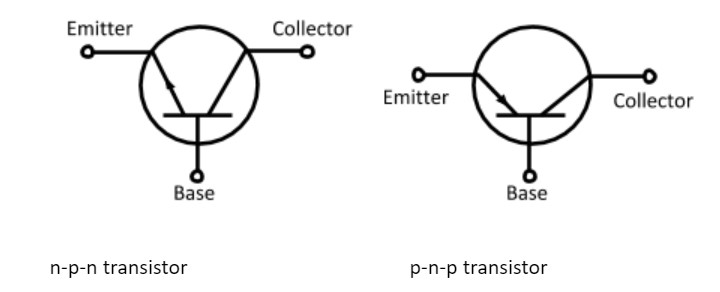
Draw the circuit symbols for p-n-p and n-p-n transistors.
Answer
508.3k+ views
Hint: In n-p-n transistors 2 segments of n-type semiconductor are separated by a segment of p-type semiconductor. While in the p-n-p transistor 2 segments of p-type semiconductor are separated by a segment of n-type semiconductor.
Complete step by step solution:
The schematic representations of an n-p-n and p-n-p configuration are given as

The sign of arrow in the circuit represents
1. Direction of current in circuit
2. Type of transistor
3. Emitter segment of transistor
Here 3 segments are present in transistor
(A) Emitter – It is of moderate size and heavily doped. It supplies a large number of majority carriers for the current flow through the transistor.
(B) Base – This is the central segment.
It is very thin and lightly doped.
(C) Collector – This segment collects a major portion of the majority carries supplies by the emitter. This collector side is moderately doped and larger in size as compared to the emitter.
Note: In order to draw the circuit diagram we must know about the direction of current and doping & thickness of emitter, collector and base.
Complete step by step solution:
The schematic representations of an n-p-n and p-n-p configuration are given as

The sign of arrow in the circuit represents
1. Direction of current in circuit
2. Type of transistor
3. Emitter segment of transistor
Here 3 segments are present in transistor
(A) Emitter – It is of moderate size and heavily doped. It supplies a large number of majority carriers for the current flow through the transistor.
(B) Base – This is the central segment.
It is very thin and lightly doped.
(C) Collector – This segment collects a major portion of the majority carries supplies by the emitter. This collector side is moderately doped and larger in size as compared to the emitter.
Note: In order to draw the circuit diagram we must know about the direction of current and doping & thickness of emitter, collector and base.
Recently Updated Pages
Master Class 12 Business Studies: Engaging Questions & Answers for Success

Master Class 12 Economics: Engaging Questions & Answers for Success

Master Class 12 English: Engaging Questions & Answers for Success

Master Class 12 Maths: Engaging Questions & Answers for Success

Master Class 12 Social Science: Engaging Questions & Answers for Success

Master Class 12 Chemistry: Engaging Questions & Answers for Success

Trending doubts
What is meant by exothermic and endothermic reactions class 11 chemistry CBSE

Which animal has three hearts class 11 biology CBSE

10 examples of friction in our daily life

One Metric ton is equal to kg A 10000 B 1000 C 100 class 11 physics CBSE

1 Quintal is equal to a 110 kg b 10 kg c 100kg d 1000 class 11 physics CBSE

Difference Between Prokaryotic Cells and Eukaryotic Cells




